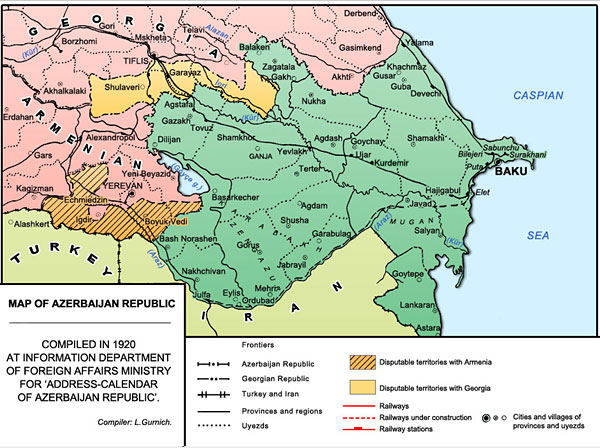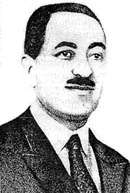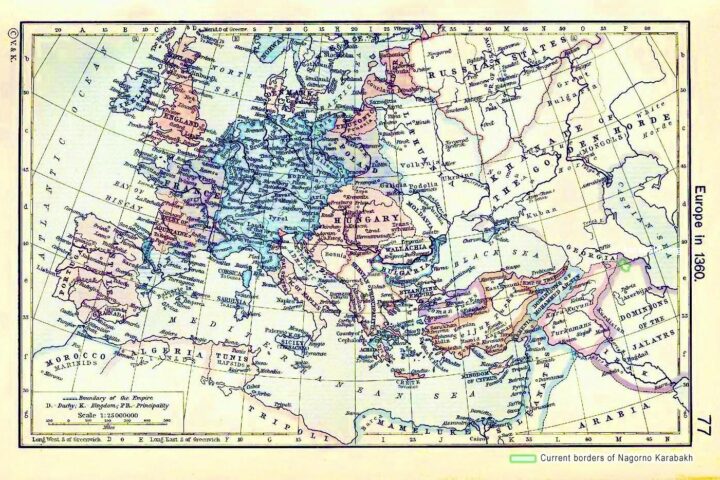
Russia’s defeat in the World War I, and as a consequence of this, overthrow of the Czarism and new wave of revolutions in 1917, created conditions for the peoples of Caucasus, as well as for all other peoples of Russian Empire, to attain independence and their own statehood. But in the meantime, collapse of past power caused the outburst of anarchy in the places and intensification of the nationalist tendencies. By May 1918 when three independent republics- the Ararat (Armenian) Democratic, Azerbaijan Democratic and Georgian Democratic republics emerged in the territory of the South Caucasus, these nations were virtually in war with one another (the Azerbaijan-Georgia relationship was an exception). Under the Russian Empire the territorial-administrative division oftentimes didn’t correspond to the ethnic borders. Therefore, the lack of clearly defined frontiers, among the new independent Caucasian republics aggravated their relations further.In March 1918 bloody clashes took place in Baku, which was controlled by the Bolsheviks, who surprisingly relied on the Armenian national-socialists – dashnaks. Seemingly, both of these forces used each other in their objectives and temporarily united in order to put an end to the increasing movement of Azeris trying to determine their political status and create their own state. It’s notable, that the Bolsheviks’ leader was also an Armenian by nationality Stepan Shaumyan, who headed the Baku Soviet. More than 10 thousand people were killed from 30 to 31 of March as a result of Azeri massacre in Baku. After Baku, the similar pogroms took place in the beginning of April in Kuba, Shemakha, Lenkoran and other places. In Kuba bolshevik-dashnak troops killed approximately 2 thousand people, the town of Shemakha was almost totally burned and leveled with earth under the command of the Armenian dashnak commanders Amazasp and Avetisov who were sent there by Shaumian’s order. Even Shaumian confessed that during the March and consequent events «the fact of participation of the national units gave the civil was a character of the national carnage». He continued further: «…it was impossible to prevent this [i.e. national carnage] We consciously allowed that…If they (i.e. «Azeris-counter-revolutionists») would gain the power in Baku, then they would have proclaimed the city the capital of Azerbaijan, and all non-Muslim elements would be disarmed and killed, Transcaucasus would be lost for Russia»[4].
The Bolshevik-dashnak union didn’t last long. In the beginning of August so called Centro-Caspian dictatorship toppled it down, and in September Baku was liberated and became the capital of the Azerbaijan Democratic Republic.While tensions in the eastern regions of Azerbaijan decreased, situation began to deteriorate in its western regions bordering Armenia, which began to lay claims to the adjacent territories of Georgia and Azerbaijan. Armenia demanded Akhalkalaki, Borchaly and the southern part of the Tiflis province from Georgia and Zangezur, Nakhichevan and mountainous part of the Yelizavetpol province including Karabakh, from Azerbaijan. Armenian territorial claims to the territories, where, in most of the cases, Armenians didn’t even constitute the majority, led to Armeno-Georgian war in December 1918 and to long and bloody fight with Azerbaijan.At this time the territory of Azerbaijan was 97.3 thousand km2 (11.3 thousand km2 more than today). Besides that, there were territories on the border with Georgia and Armenia, totaling 16.6 thousand km2 that were contested (Karabakh wasn’t among these territories). And if in case with Georgia the issue of contested borders was solved through peaceful negotiations, then, in case with Armenia, negotiations end up with nothing.The British journalist Scotland-Liddel, who have been in the conflict areas in the Caucasus in 1919-1920 wrote in January 1919: «On November 23 a treaty was concluded in Tiflis and there came hope, that both parties [i.e. Armenia and Azerbaijan] would live in peace until all the questions are solved by the Great Powers [in the Versailles Peace Conference]. However, immediately, almost following the signing of the treaty, Armenians, having benefited from the withdrawal of the Azerbaijanian troops, treacherously attacked the Muslims.
On January 19 Armenian government troops together with local armed Armenian bands began to advance towards the Shusha district of Karabakh. All the Muslim villages, in a total number of 9, situated on their way, were demolished and most part of the population was inhumanly killed»5.In the end of 1918- beginning of 1919 situation in Karabakh and other western parts of Azerbaijan considerably aggravated. The Azeri villages of Zangezur and Karabakh were constantly undergoing attacks on the hands of the Armenian armed groups headed by the dashnak general Andranik, notoriously known for his brutalities over the civilian population yet in Turkey. By its forceful actions, Armenian government tried to strengthen it’s «rights» to these territories in the eve of the Versailles Peace Conference, where all the questions regarding the borders of the South Caucasian republics should have been finally solved. Many villages of Karabakh and especially, those of Zangezur were demolished, population of some of them almost totally exterminated. The number of refugees from Armenia and from bordering regions reached 150.000 people in Azerbaijan. Shusha was almost totally in blockade and isolated from the outer world. There was a severe shortage of products in the town.In order to solve these problems Khosrov bey Sultanov was appointed to the newly created general-governor’s position in January 1919.Khosrov bey Sultanov, General Governor of Karabakh and Zangezur”]
Three aides from the Azeri and three from the Armenian sides assisted the governor in his work. The general-governor-administered territories included the Shusha, Zangezur, Jevanshir and the Jebrayil districts. The Armenian authorities hurried to protest against this decision of the Azerbaijanian government and having evaluated it as «violation of the territorial rights of Armenia» appealed to the commander-in-chief of the Allied forces in the Caucasus general Thompson. But Thompson, who arrived in the Caucasus in November 1918 and had already got acquainted with the situation, recognized the legitimate rights of the Azerbaijanian government with regard to its internal affairs and also recognized the authority of the Karabakh’s general-governor.
In summer 1919 the situation in Azerbaijan worsened again as a result of threat of invasion of the general Denikin’s White Guard Army from the north. While Azerbaijan and Georgia signed a military-defense pact on collective resistance in case of Denikin’s aggression, Armenia signed a similar treaty with Denikin. In June having benefited from this situation, the Armenian armed forces again intruded into Zangezur and from there, into Karabakh. Andranik, together with his dashnaks attempted to seize Shusha three times, but each time, due to the collective efforts of the units of the National Army and local Azeri population, had to retreat.

The Governor of Karabakh
Khosrov bey Sultanov took effective measures for organizing the defence of Karabakh and also for neutralizing the heads of the local separatists and extremists. Having exiled some irreconcilable members of the local Armenian national council, he restored, for some time, stability and order in Karabakh without bloodshed. Sultanov also made steps towards normalization of relations between the Armenian and the Azeri population of Karabakh. In Shusha the Armenians began to attend the Azeri part of the town again, and the Azeris, without fear- the Armenian part. The town became united again. Much work was done to secure safety of the Armenian population of Karabakh. For example, in June 1919 and information was received, that 200 Shushavian riders were going to attack the neighboring Armenian village of Dashalty to avenge Andranik’s attacks to the Azeri villages in Zangezur. Immediately, units of the National Army were sent to Dashalty. Troops reached there and dispersed the attackers in good time, when these bands had already burned the outermost house of the village, moreover, the attackers lost three people dead.[6]
Restoration of stability, even though was temporary, but led to bettering of the interethnic relations and in August 1919 the Armenian community of Karabakh in its congress officially recognized the authority of the Azerbaijanian government.
The Azerbaijanian government achieved considerable success in the international area as well. On January 11, 1920 the Supreme Council of the Allies made a decision in Versailles: «The Allied and League [of Nations] countries de-facto recognize the governments of Azerbaijan and Georgia»[7]. Soon a similar decision was made with regard to Armenia too. Unsolved territorial disputes among the Caucasian republics hampered them to be recognized in de-jure level.
Nevertheless, news about recognition of the Azerbaijan’s sovereignty reached the country in March and became the reason for great celebrations. A general amnesty was declared; a military parade was organized in Baku.
But this joy didn’t last long. At night on March 22 1920, the day when Azeris celebrated the spring holiday of Novruz, Armenian nationalist groups organized a riot. The objective was to catch the Azeris distracted with holiday unawares and to take control over Shusha. They seized the approaches to Shusha, Khankendi, and the Askeran fortress and began to attack the Azeri part of the town and burn the houses on their way.
Approximately, the same time the regular army units of Armenia attacked Zangezur. But the effect of suddenness didn’t justify itself. On the contrary, the fact that Armenians attacked Azeris during their holy holidays embittered the conflict further. The Azeri population and the units of the National Army dislocated in Shusha, consolidated and began counteroffensive to the Armenian quarter of Shusha and burned almost the whole Armenian part of the town. Both parties suffered great losses. Losses from the Armenian part were more. Regular units of the Azerbaijan Army under the command of general-major Habib Salimov were sent to Karabakh and Zangezur. The riot in Karabakh was suppressed, and by the end of April 1920 the Azerbaijan Army defeated the Armenian troops in Zangezur. On April 26 the Armenian government asked for peace.
But despite the military victory, the events of March-April 1920 had very negative consequences for Azerbaijan. These events caused the governmental crisis in Azerbaijan. The government under the pressure from the Parliament opposition, accusing it in inept governance, had to resign. Attempts to create a new government didn’t succeed. The Bolsheviks used the situation to seize the power. Involvement of the major forces of the Azerbaijan Army in the conflict with Armenia in the western borders made Azerbaijan virtually helpless before the aggression at the hands of a more powerful enemy from the North. On April 27 the Russian XI Red Army intruded into Azerbaijan and on April 28 the Soviets came into the power in Baku virtually unimpeded. The independence of Azerbaijan was over.
Shusha itself also greatly suffered from the events of March 1920. This beautiful town, which was one of the biggest cultural and political centers of Azerbaijan once called «petite Paris» for its beauty, the cradle of the Azeri music named by rights «the Conservatoire of the Caucasus» couldn’t recover from this last strike and gradually became a small provincial town.
- S. Shaumyan «Articles and speeches 1917-1918» (Stat’yi i rechi 1917-1918 gg) Baku 1929 p. 260 (in Russian)
- «War with Muslims, Armenians attack again» Scottland-Liddel January 30, 1919 / Central State Archive of Azerbaijan Republic reserve 894, inventory 10, folder (delo) 81, lists 9-10 / Documents and Publications… p. 257
- «Last events in Karabakh» Azerbaijan newspaper No 123, June 17 1919 / also: Documents and Publications p. 313 (in Russian)
- «Paris Peace Conference» Washington 1947 vol. IX p. 959 / also: D. Gassanov «Azerbaijan within the system of international relations 1918-1920» (Azerbaycan beynelxalq munasibetler sisteminde 1918-1920) Baku 1993 p. 320 (in Azeri)





